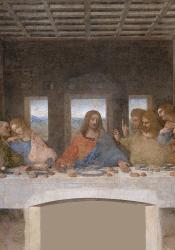Restoration and Current State of the Last Supper
With a painting that was subject to so much damage yet by such a renowned artist as da Vinci, it is not surprising that many restorations have been attempted. More than six were attempted between 1700 and 1900, with the most recent and extensive taking place in 1977. Before this attempt, prior restorations usually painted over da Vinci’s work, but this resulted in a buildup of paint and distortion of the figures and details. In 1977, Milan decided to use modern technology such as microscopic photographs, core samples, infrared reflectoscopy, and sonar to remove added layers of paint and reveal da Vinci’s original work. This restoration took more than 38,000 hours and resulted in a painting where 42.5% of da Vinci’s work has been preserved. In the Last Supper today, one can see that the tiny paint flakes that have chipped off throughout the entire painting sadly make it appear extremely faded and blurry.
While historians desperately want to prevent any future damage to da Vinci’s masterpiece, they also understand the cultural importance of it being open for viewing, instead of paranoidly hidden away – after all, art is meant to be seen. Today, travelers in Milan can go to Santa Maria delle Grazie to see The Last Supper, albeit with some restrictions – visitors can only remain in front of the painting for 15 minutes, and a maximum of 30 people are allowed into the refectory at a time to minimize overcrowding. Visitors must pass through an air-lock system that helps purify them and keep pollution from reaching the painting, and air quality monitors and air filters are also installed to monitor the painting.
da Vinci’s great painting reveals his personality of constantly trying to discover new ideas and experimenting in all areas of life, yet the fact remains that he was only human and of course failed occasionally. His painting was “innovative in its heart and too innovative in its methods. The conception was brilliant but the execution flawed” (Issacson p. 292). The remains of The Last Supper exemplify Renaissance painting principles and show how da Vinci’s mastery of these techniques allowed him to go beyond the limits of art to create movement, emotion, and realism.
Sources:
Harris, B. & Zucker, S. (n.d.) The Last Supper. Retrieved from https://www.khanacademy.org/humanities/ap-art-history/early-europe-and-colonial-americas/renaissance-art-europe-ap/a/leonardo-last-supper
The Last Supper – by Leonardo da Vinci. (2011). Retrieved from https://www.leonardodavinci.net/the-last-supper.jsp
Image Source:
Da Vinci, L. (1498) The Last Supper. [Painting] Retrieved from https://en.wikipedia.org/wiki/The_Last_Supper_(Leonardo)

